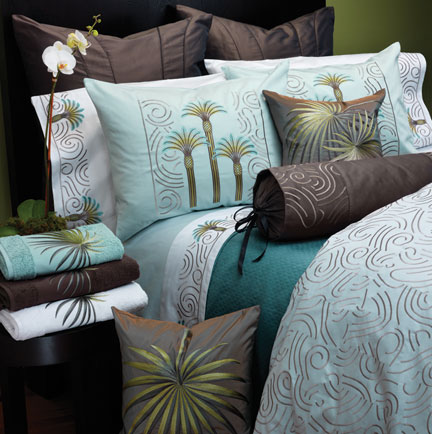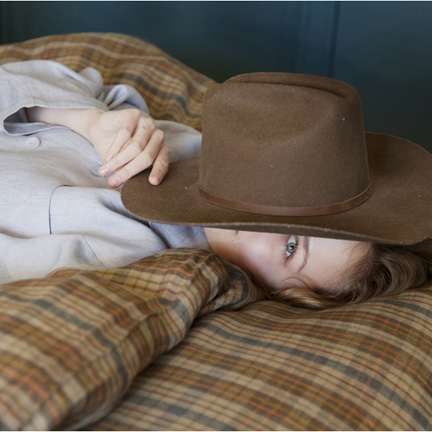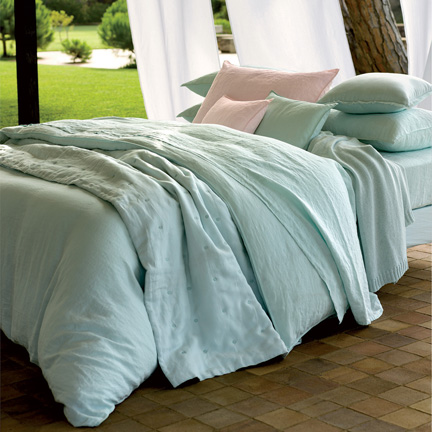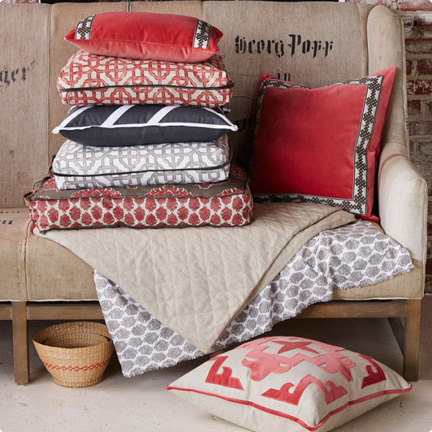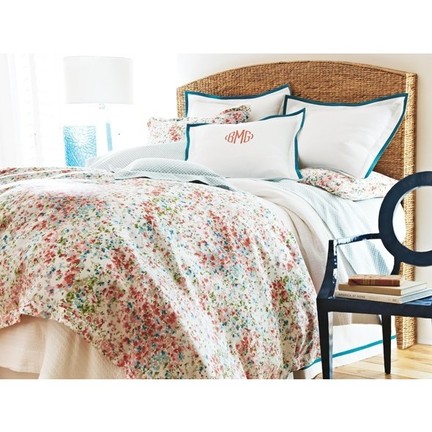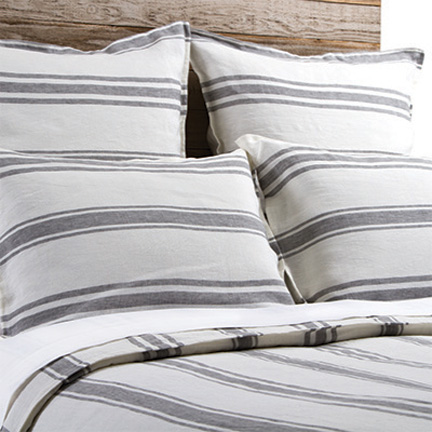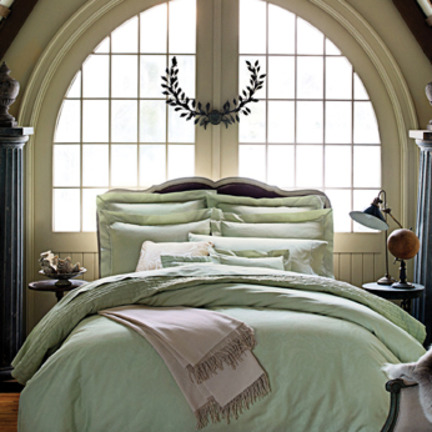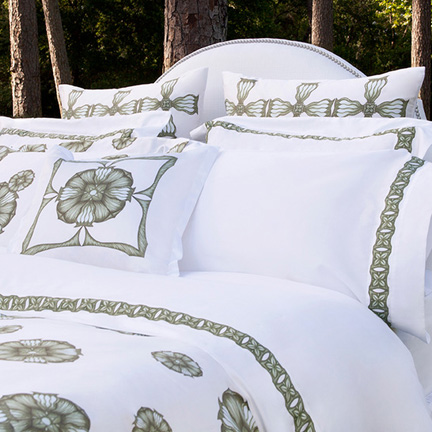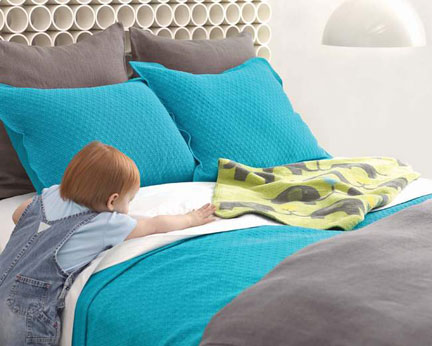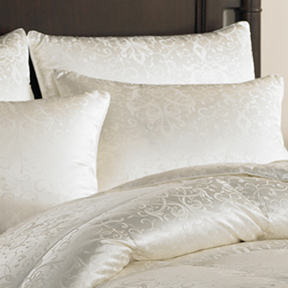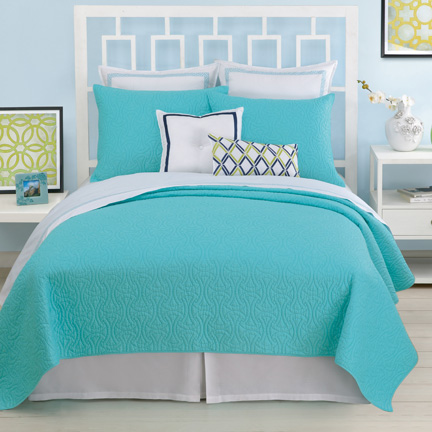Save to...
Guide to Choosing Bed Linens
We typically spend a third of our lives in our bedroom, so be sure to get a set of linens you’ll love using over and over again.
Understanding Bedding Materials
What should I look for in finer linens?
Finer linens are usually characterized by a combination of beautiful materials, expert construction, and design. Most fine linens are made from linen or cotton because they are durable, absorbent, and they become softer with use and laundering.
Finer linens are smooth and soft (no coarse knots or uneven slubs should be visible); they may also be lustrous, but never shiny. Workmanship is key: all designs must be precisely executed, all colors uniform, and all seams must be finished evenly to ensure they’ll last for years.
What is the difference between linen and cotton?
Both linen and cotton are natural fibers: linen comes from the flax plant and cotton comes from the cotton plant. Both fabrics are highly absorbent, durable, and become softer with use. Generally, linen feels lighter and has more texture, but it requires pressing after use. Cotton, on the other hand, feels more substantial and is better for reproducing printed designs. It is by far the most popular choice for bedding, so it is more widely available and generally more affordable.
What is Egyptian cotton?
Because the humid weather and rich soil around the Nile delta produce especially delicate and long fibers, Egyptian cotton is by far the finest variety of cotton in the world. These longer fibers allow for a finer, more continuous thread, and a higher number of threads per square inch, resulting in a stronger and softer material.
What is sateen?
Sateen is cotton made with a satin weave. Rather than a one-over-one weave like percale, the warp or weft threads passed over several filling threads, creating a fabric with a silken feel and a very smooth and lustrous surface. Sateens can be produced in both light and heavy weights; they should ideally be ironed after washing to restore their luster.
What is percale?
Percale is a closely woven, plain weave, meaning that the warp and weft threads cross each other one at a time. They are a tighter weave with a thread count of at least 180. Percale can be made of any fiber but are usually cotton or a cotton/polyester blend.
Why is thread count so important?
The term “thread count” refers to the number of threads in one square inch of fabric. Higher thread counts mean a tighter weave, a softer and stronger fabric, and a finer quality. For a luxurious feel, we recommend fabrics with at least 300 thread count.
While important, thread count should always be considered in conjunction with the quality of the fiber, workmanship and finishing process used on the linens. Always make sure that the highest quality fiber is used because a high thread count sheet made from lower quality fibers will feel heavy and coarse instead of soft and luxurious.
Choosing a Size
What are standard mattress sizes?
| Twin | 39″ x 75″ |
| Full (Double) | 54″ x 75″ |
| Queen | 60″ x 80″ |
| King | 76″ x 80″ |
| California King | 72″ x 84″ |
What are the dimensions of your bed linens?
Actual dimensions vary between collections, but they are generally as follow:
| Neckroll | 16″ x 20″ |
| Boudoir shams | 12″ x 16″ |
| Standard pillowcase | 21″ x 33″ |
| Queen pillowcase | 21″ x 39″ |
| King pillowcase | 21″ x 43″ |
| Standard shams | 20″ x 27″ |
| King shams | 20″ x 37″ |
| Euro shams | 26″ x 26″ |
| Twin Flat | 71″ x 110″ |
| Full Flat | 87″ x 110″ |
| Queen Flat Sheet | 95″ x 118″ |
| King Flat Sheet | 108″ x 120″ |
| Twin Fitted Sheet | 39″ x 76″ x 17″ |
| Full Fitted Sheet | 54″ x 76″ x 17″ |
| Queen Fitted Sheet | 60″ x 80″ x 17″ |
| King Fitted Sheet | 78″ x 80″ x 17″ |
| Cal King Fitted Sheet | 72″ x 84″ |
| Twin Duvet Cover | 64″ x 86″ |
| Full Duvet Cover | 82″ x 90″ |
| Queen Duvet Cover | 90″ x 90″ |
| King Duvet Cover | 104″ x 90″ |
Care and Suggested Quantities
How do I care for my bed linens?
You should always wash your bed linens before putting them on your bed for the first time. Be sure to wash your sheets regularly (remember that natural fibers get softer with each wash) in warm water with like colors and tumble dry on medium. Do not use bleach or fabric softener because it can damage fibers and make the sheets less soft over time. For less wrinkle in your sheets, remove them promptly from the dryer and put them on the bed or fold them right away. If you do want to iron your bed linens, take out of the dryer slightly damp for easier ironing, and always press embroideries on the reverse side.
How many bed linens do I need?
We recommend that a basic collection of bed linens include one set for the bed, one set for the laundry, and one set for the linen closet. A full list of recommended items includes:
- 3 Complete sheet sets (flat, fitted, 2 pillowcases each)
- 1 Medium or heavyweight comforter
- 2 Blankets or throws (1 light for summer, 1 heavy for winter)
- 2 Pillow shams in the size of your choice (standard, queen, king)
- 2 Decorative pillow shams (boudoir or neck roll)
- 1 Duvet cover
- 1 Bed skirt
- 1 Mattress pad
- 1 Complete sheet set per guestroom
- 1 Blanket per guestroom

